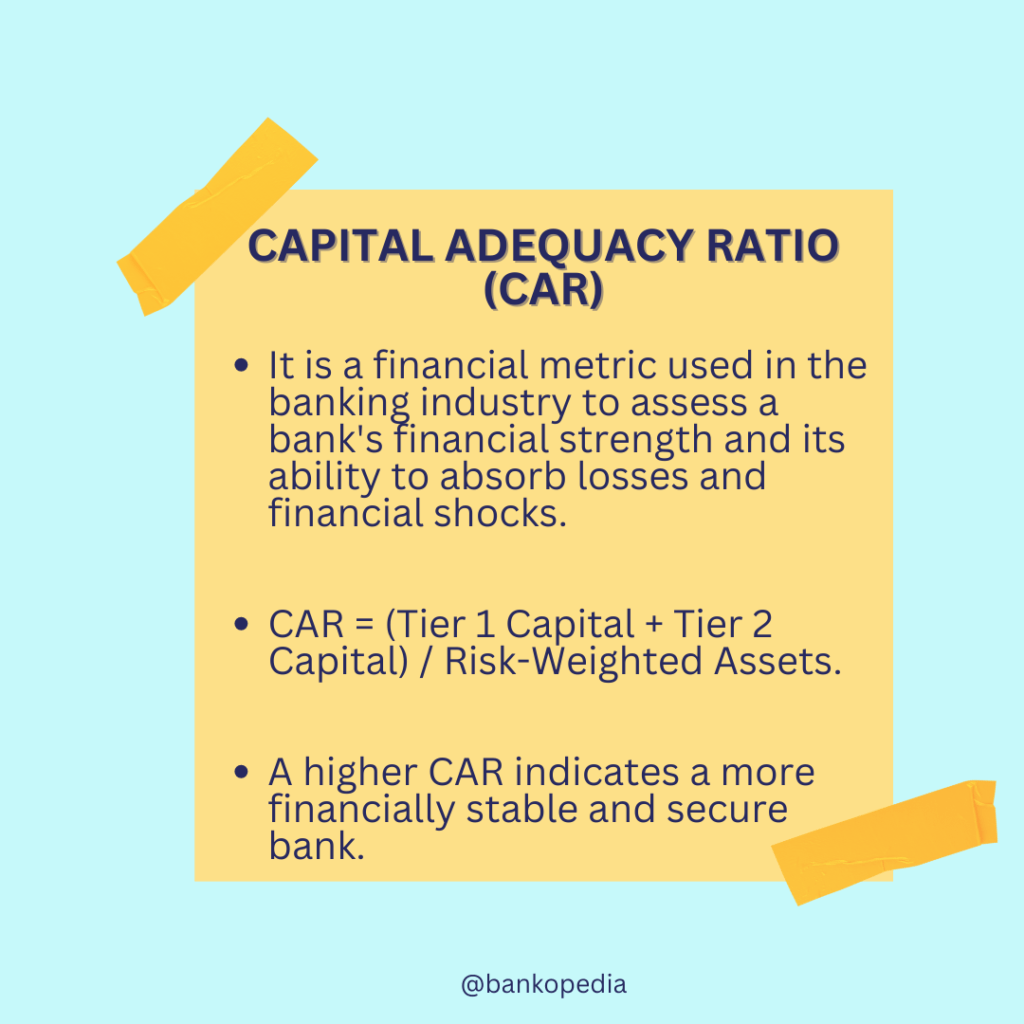One of the key measures used to assess the financial strength of banks is the Capital Adequacy Ratio (CAR). In India, the CAR is governed by the Reserve Bank of India (RBI) through its guidelines and regulations. In this comprehensive guide, we will delve into the importance of the Capital Adequacy Ratio for Indian banks and understand its components, calculations, and requirements.

Why is Capital Adequacy Ratio important for Indian banks?
The Capital Adequacy Ratio is a measure of a bank’s ability to absorb losses and maintain its financial stability. It ensures that banks have enough capital to cover potential losses arising from credit, market, and operational risks. For Indian banks, the CAR is of utmost importance as it safeguards the interests of depositors and promotes a stable and secure banking system.
A high Capital Adequacy Ratio indicates that a bank has sufficient capital to withstand adverse economic conditions, while a low ratio suggests vulnerability and potential financial instability. The higher the CAR, the more confidence depositors and investors have in the bank’s ability to fulfill its obligations.
Components of Capital Adequacy Ratio
The Capital Adequacy Ratio comprises two key components: Tier 1 capital and Tier 2 capital. Tier 1 capital, also known as core capital, represents the highest quality capital a bank possesses. It includes equity capital, disclosed reserves, and other instruments of perpetual nature. Tier 2 capital, on the other hand, includes subordinated debt, general provisions, and revaluation reserves.
The combination of Tier 1 and Tier 2 capital provides a comprehensive measure of a bank’s financial strength. These components not only act as a buffer against potential losses but also contribute to the overall risk-bearing capacity of the bank.
Understanding Risk-Weighted Assets
To calculate the Capital Adequacy Ratio, banks must first determine their Risk Weighted Assets (RWA). Risk-weighted assets are a measure of the potential risk associated with a bank’s assets, such as loans, investments, and off-balance sheet exposures. Different types of assets carry different risk weights, with riskier assets assigned higher weights.
The RWA calculation takes into account various factors, such as credit risk, market risk, and operational risk. By assigning appropriate risk weights to different assets, banks can accurately assess the amount of capital required to cover potential losses.
Calculation of Capital Adequacy Ratio
The Capital Adequacy Ratio is calculated by dividing a bank’s capital (Tier 1 + Tier 2) by its Risk Weighted Assets. The result is then multiplied by 100 to express the ratio as a percentage. The formula can be represented as follows:
Capital Adequacy Ratio = (Tier 1 capital + Tier 2 capital) / Risk Weighted Assets * 100
For example, if a bank has a Tier 1 capital of Rs. 500 crore, Tier 2 capital of Rs. 300 crore, and Risk Weighted Assets of Rs. 10,000 crore, the Capital Adequacy Ratio would be:
CAR = (500 + 300) / 10,000 * 100 = 8%
Tier 1 capital and its significance
Tier 1 capital is considered the most reliable form of capital for banks as it consists of equity and disclosed reserves. It acts as a primary loss-absorbing capacity and provides a strong foundation for the bank’s financial stability. A higher Tier 1 capital indicates a bank’s ability to absorb losses and withstand adverse economic conditions.
The significance of Tier 1 capital becomes even more prominent during times of financial distress. It enables banks to maintain confidence among depositors and investors, ensuring their continued support and preventing a potential run on the bank.
Tier 2 capital and its role in Capital Adequacy Ratio
Tier 2 capital, although considered less reliable than Tier 1 capital, still plays a crucial role in the overall Capital Adequacy Ratio. It includes items such as subordinated debt, general provisions, and revaluation reserves. Tier 2 capital acts as a secondary loss-absorbing capacity and provides additional support to the bank’s financial position.
While Tier 2 capital carries higher risk than Tier 1 capital, it enhances the overall risk-bearing capacity of the bank. It acts as a cushion against unexpected losses and contributes to the bank’s ability to maintain adequate capital levels.
Capital Adequacy Ratio Requirements in India
The Reserve Bank of India (RBI) has set minimum Capital Adequacy Ratio requirements for banks operating in India. As per the latest guidelines, Indian banks are required to maintain a minimum CAR of 9%. This ensures that banks have sufficient capital to absorb losses and maintain financial stability.
In addition to the minimum requirement, the RBI also sets additional capital adequacy norms based on factors such as the size, complexity, and risk profile of the bank. These norms aim to address specific risks associated with each bank and ensure the stability of the overall banking system.
Challenges faced by Indian banks in maintaining Capital Adequacy Ratio
Indian banks face several challenges in maintaining the required Capital Adequacy Ratio. One of the major challenges is the need for additional capital infusion to meet the regulatory requirements. This often requires banks to raise capital through various means, such as equity dilution or external funding, which can be a time-consuming and costly process.
Moreover, the dynamic nature of the banking industry and changing economic conditions pose challenges in accurately assessing the Risk-Weighted Assets. Banks must continuously evaluate and adjust their risk weights to reflect the changing risk profiles of their assets.
Conclusion: The significance of Capital Adequacy Ratio in ensuring the stability and resilience of Indian banks
In conclusion, the Capital Adequacy Ratio plays a vital role in assessing the financial strength and stability of Indian banks. It ensures that banks have sufficient capital to absorb potential losses and maintain the confidence of depositors and investors. The combination of Tier 1 and Tier 2 capital, along with the calculation of Risk Weighted Assets, provides a comprehensive measure of a bank’s ability to withstand adverse economic conditions.
While Indian banks face challenges in maintaining the required Capital Adequacy Ratio, it remains a critical aspect of the regulatory framework. The guidelines set by the Reserve Bank of India aim to safeguard the interests of depositors and promote a stable and secure banking system. By adhering to these requirements, Indian banks can enhance their resilience and contribute to the overall growth and development of the economy.










